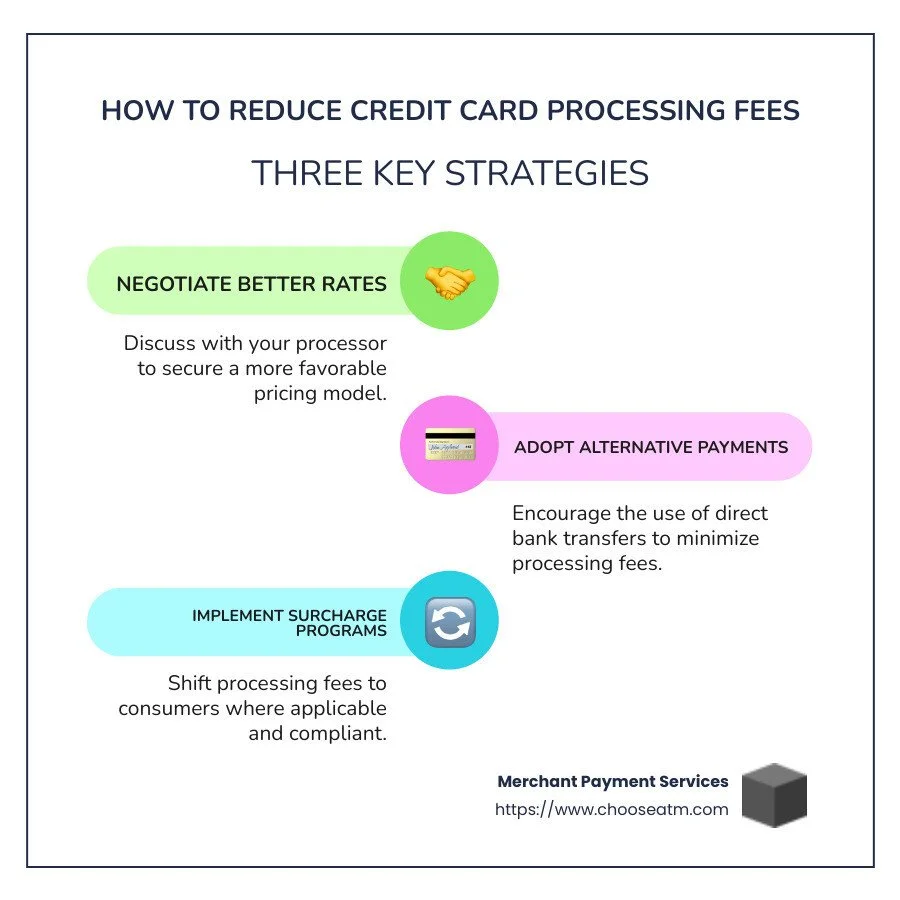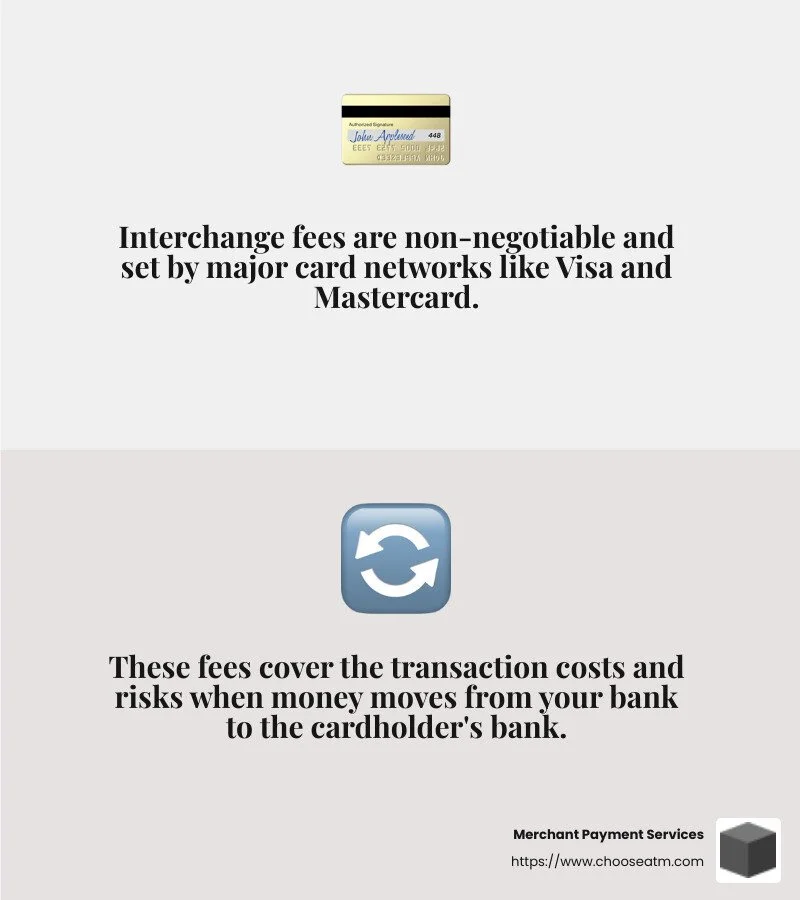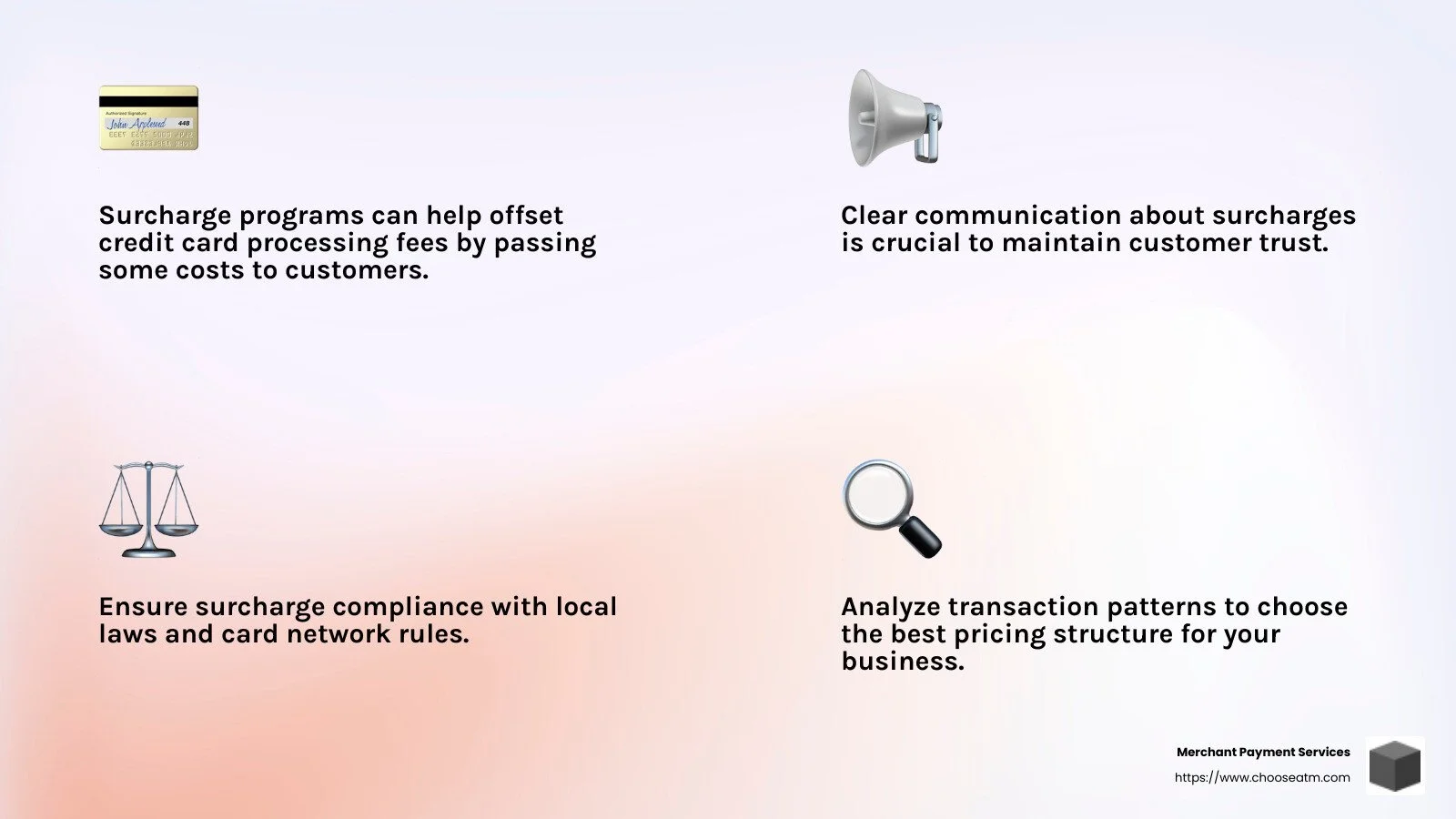Fee Fighters: A Guide to Reducing Credit Card Processing Costs
How to reduce credit card processing fees is a pressing concern for many small businesses looking to bolster their bottom line. Understanding these fees is crucial, as they can significantly chip away at your profits over time. To tackle this, consider the following quick strategies:
Negotiate with your processor for a better pricing model.
Adopt alternative payment methods like direct bank transfers.
Settle transactions promptly to avoid costly downgrades.
Leverage surcharge programs to pass fees onto consumers where applicable.
As a small business owner, managing your credit card processing fees effectively can lead to increased savings and streamlined operations.
Credit card processing fees are more than just a minor expense—they are an essential aspect of running both online and physical stores. As these fees can range from 1.5% to 3.5% of every transaction, they often become a significant part of your business expenses. This guide will help break down how these fees work and provide actionable strategies to reduce them.
Hello! I'm Lydia Valberg, co-owner of Merchant Payment Services. With over 35 years in the payment solutions industry, I specialize in helping businesses like yours understand how to reduce credit card processing fees to boost profitability.
Understanding Credit Card Processing Fees
When you dive into credit card processing, you'll encounter several types of fees that impact your bottom line. Let's break these down to see where your money goes and how you might save some of it.
Interchange Fees
Interchange fees are the backbone of credit card processing costs. They're paid by your bank to the cardholder's bank every time a transaction occurs. These fees are set by the card networks like Visa and Mastercard and are non-negotiable. They cover the risk and cost of handling the transaction.
Transaction Fees
Transaction fees are what your payment processor charges for each transaction. These can vary based on the processor and the type of transaction. For example, a swipe at a physical terminal might cost less than a keyed-in entry online due to fraud risks.
Merchant Discount Rate
The merchant discount rate is the total percentage of each sale that goes to covering processing costs. It includes the interchange fee, assessment fees, and any markup by your payment processor. This rate can range from 1.5% to 3.5%, but can be higher depending on several factors like the type of card used or the nature of the transaction.
How These Fees Affect Your Business
Understanding these fees is crucial because they directly affect your profit margins. For instance, if your average transaction is $100 and your merchant discount rate is 2.5%, you're paying $2.50 per transaction. Over time, this adds up, especially for businesses with high volumes or small margins.
To manage these costs, it's important to consider negotiating with your processor, choosing a pricing model that suits your business, and looking for ways to pass some of these costs onto consumers through surcharge programs.
Next, we'll explore how to reduce credit card processing fees by looking at different pricing structures, surcharge programs, and negotiation strategies.
How to Reduce Credit Card Processing Fees
Reducing credit card processing fees can significantly improve your business's profitability. Here are some effective strategies to consider:
Pricing Structures
Choosing the right pricing structure can make a big difference in your processing costs. Here are the most common types:
Flat-Rate Pricing: You pay a single rate for all transactions, regardless of the card type. This is simple but might not be the most economical for businesses with high transaction volumes.
Tiered Pricing: Transactions are categorized into different tiers (qualified, mid-qualified, non-qualified), each with its own rate. This can be complex and often results in higher costs.
Interchange-Plus Pricing: You pay the actual interchange fee plus a fixed markup. This model offers transparency and can be cost-effective for businesses with high volumes.
Pro Tip: Analyze your transaction patterns to determine which pricing structure aligns best with your business needs.
Surcharge Programs
Implementing a surcharge program allows you to pass some of the processing fees to your customers. Here's how it works:
Add a Small Fee: You tack on a small fee to credit card transactions. This helps offset the costs of processing fees.
Communicate Clearly: It's crucial to inform your customers about these fees upfront to maintain transparency and trust.
Compliance: Ensure your surcharge program complies with local laws and card network rules. Some regions have specific regulations regarding surcharges.
Negotiation Strategies
Don't underestimate the power of negotiation when it comes to reducing fees. Here are some tips:
Shop Around: Research and compare different payment processors to find the best rates. Don't settle for the first offer you receive.
Leverage Volume: If you have a high transaction volume, use it as leverage to negotiate better rates with your processor.
Ask for Discounts: Sometimes, simply asking your processor for a discount can lead to lower fees. Many businesses have successfully reduced their rates just by asking.
Get it in Writing: If you negotiate a new rate, make sure to get the agreement in writing to avoid any misunderstandings later.
By focusing on these strategies, you can effectively reduce credit card processing fees and improve your business's bottom line. Next, we'll dive into the top strategies to minimize fees further, including choosing the right cards and utilizing address verification.
Top Strategies to Minimize Fees
Reducing credit card processing fees is crucial for improving your profit margins. Let's explore some top strategies that can make a significant difference.
Choose the Right Cards
Not all cards are created equal when it comes to processing fees. Some credit cards, especially premium rewards cards, come with higher costs.
Tip: Evaluate which card types your customers use most frequently and consider limiting acceptance to those that align with your business model. This can help you manage costs more effectively.
Address Verification
Implementing an Address Verification Service (AVS) can reduce your risk of fraudulent transactions. AVS compares the billing address provided by the customer with the one on file with the credit card issuer.
Why It Matters: Transactions verified through AVS are considered lower risk, which can result in lower processing fees. Additionally, it helps reduce chargebacks, saving you money.
Batch Processing
Batch processing can be a game-changer for lowering fees. Here's how it works:
Daily Batching: Submit transactions within 24 hours to qualify for lower rates. Delaying this can lead to higher fees.
Consistent Habits: Make it a routine to batch daily, reducing the number of transactions processed at higher rates.
By choosing the right cards, using address verification, and optimizing batch processing, you can significantly minimize credit card processing fees. These strategies, combined with the ones discussed earlier, will help you keep more of your hard-earned money.
Next, we'll explore how implementing a surcharge program can further assist in managing these costs.
Implementing a Surcharge Program
Adding a surcharge program to your payment strategy can be a smart move for reducing credit card processing fees. Here's how it works and what you need to know to get started.
Surcharge Benefits
Surcharging allows you to pass the cost of credit card processing fees directly to your customers. This can immediately reduce your business expenses and improve your profit margins.
Key Benefit: By implementing a surcharge, you can keep your prices competitive while covering the extra costs associated with credit card transactions. This can be particularly beneficial for businesses with low-ticket items, where fees can eat into profits.
Customer Communication
Clear communication with your customers is crucial when implementing a surcharge program. You want to ensure that customers understand why the surcharge is being applied and how it benefits them in the long run.
Tips for Communication:
Transparency: Clearly display surcharge information at the point of sale and on your website. Customers should never be surprised by additional fees.
Positive Framing: Explain that the surcharge helps maintain low prices and that customers can avoid the fee by using alternative payment methods like cash or debit cards.
Education: Inform customers that surcharges are a common practice and help businesses manage operational costs effectively.
Compliance
When adding a surcharge, compliance with state laws and card network rules is essential. Each state has different regulations, and card networks like Visa and Mastercard have specific guidelines you must follow.
Compliance Checklist:
State Laws: Verify if your state allows surcharging and understand any specific limitations or requirements.
Card Network Rules: Follow guidelines such as capping surcharges at 4% or less of the transaction amount and notifying card networks of your intent to surcharge.
Clear Disclosure: Ensure that surcharges are clearly disclosed to customers before completing a transaction.
Implementing a surcharge program can be a powerful tool for managing credit card processing fees. By communicating effectively with your customers and adhering to compliance requirements, you can take control of these costs while maintaining positive customer relationships.
Next, we'll dive into some frequently asked questions about reducing credit card processing fees.
Frequently Asked Questions about Reducing Credit Card Processing Fees
How can I lower my credit card processing fees?
Lowering your credit card processing fees involves a mix of strategies. Start by negotiating with your payment processor. Many businesses don't realize that these fees can be negotiable. If your transaction volume has increased or your business has a low chargeback rate, you might be in a strong position to ask for better terms.
Consider adopting a surcharge program. This lets you pass the cost of processing fees to your customers, which can significantly reduce your business expenses. However, be sure to comply with card network rules and state laws.
Additionally, evaluate your pricing structure. Some businesses benefit from flat-rate pricing, while others might find interchange-plus pricing more economical. Analyze your transaction patterns to see if switching could save you money.
Is there a way to avoid credit card processing fees?
While you can't completely avoid credit card processing fees, you can minimize them by encouraging customers to use alternative payment methods. Offering cash discounts is a popular strategy. By giving a small discount for cash payments, you can save on processing fees and potentially speed up transaction times.
Another option is to promote ACH payments. These electronic bank transfers often have lower fees compared to credit card transactions. This method can be particularly beneficial for businesses with recurring payments or larger transactions.
Also, keep an eye out for unnecessary fees. Some processors bundle hidden fees into their charges. Review your merchant statement carefully and question any fees that seem unclear or unwarranted.
How do I offset credit card processing fees?
Offsetting credit card processing fees can be achieved through a combination of service fees and convenience fees. Service fees can be applied to certain transactions to cover processing costs, while convenience fees are charged when customers use a particular payment method, like online payments.
Additionally, review your processor agreements regularly. Ensure you understand all the terms and conditions, and look for opportunities to renegotiate for better rates or terms.
By implementing these strategies, you can better manage and reduce the impact of credit card processing fees on your business.
Next, we'll conclude with how Merchant Payment Services can help you maximize profits and simplify management.
Conclusion
Reducing credit card processing fees is crucial for businesses looking to maximize profits and streamline operations. At Merchant Payment Services, we specialize in helping businesses achieve these goals through our comprehensive ATM management solutions.
With over 35 years of experience, we understand the complexities of payment processing and offer strategies that can significantly lower your fees. Our services include access to top ATM brands, which not only improve your profits through surcharge revenue but also reduce reliance on costly card transactions.
Our mission is to simplify ATM ownership and management. We take care of the intricate details, so you can focus on running your business. By partnering with us, you gain a trusted ally committed to boosting your cash flow and increasing foot traffic to your location.
Interested in learning more about how we can help reduce your credit card processing fees and lift your business? Visit our Merchant Payment Services homepage to explore how we can make a difference for you.
By choosing the right payment strategies and partners like Merchant Payment Services, you can effectively manage your credit card processing fees and keep your business thriving.




